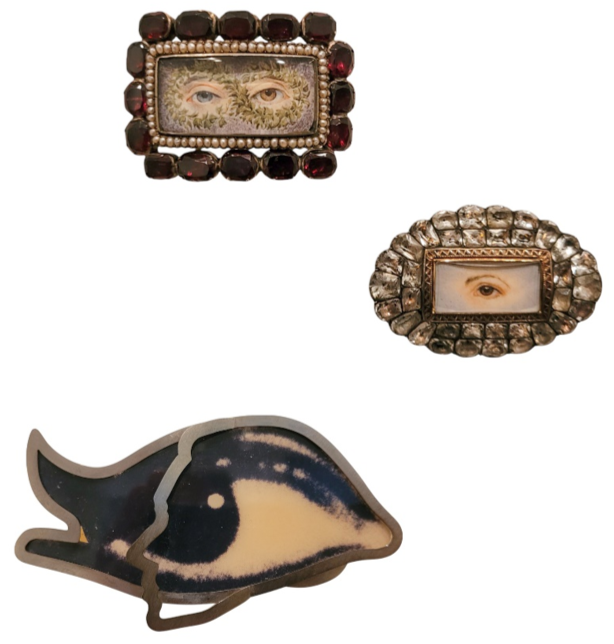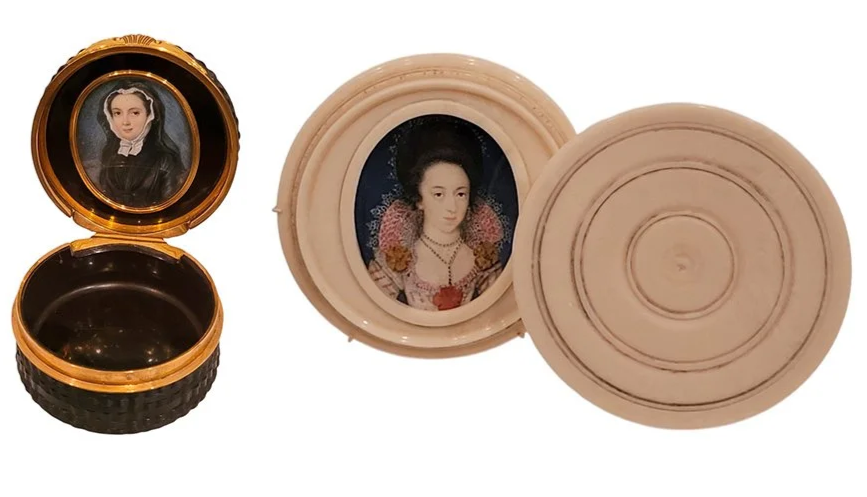THE LANGUAGE OF JEWELRY
Jewelry at the Museum of Fine Arts, Houston
FOR YOUR EYES ONLY: THE SECRET LANGUAGE OF JEWELRY
An Exhibit at the Houston Museum of Fine Arts (HMFA)
Top: Double Lover’s Eye, England, circa 1840. Watercolor on ivory, seed pearls, and gold. Private collection.
Middle: Lover’s Eye, England, circa 1714 – 1837. Watercolor on ivory, paste, gold, and silver. Private collection.
Bottom: Callas Brooch, a gift from Megan Staffel and Graham Marks, by Gijs Bakker, 1991. Silver, photograph, and plexiglass. The striking eye featured in this brooch was created from a photograph of the legendary opera diva Maria Callas. For Dutch designer Gijs Bakker, Callas epitomized a revolutionary approach that reshaped his perception of music. By concentrating solely on her gaze, Bakker skillfully employed silver to accentuate the eye, with its contours seamlessly transitioning into the soprano's iconic profile, thereby subtly revealing the identity of his muse.
The HMFA annually rotates its jewelry loans and donations, showcasing exquisite and rare pieces that span centuries. The current exhibition, "For Your Eyes Only: The Secret Language of Jewelry," presents a striking departure from traditional jewelry, which is typically worn to signify status or wealth. Instead, these intimate adornments were designed to carry private meanings known only to the wearer.
The settings often formed part of the secret message conveyed through the jewelry. Garnets were frequently used to express friendship, while turquoise, being rare and valuable, was believed to protect the wearer from ill health. Pearls, due to their purity, perfection, and cost, were regarded as symbols of the very nature of love.
The collection spans from the 17th century to the present day. It features deeply personal pieces, such as miniature portraits and delicate locks of hair, serving as cherished reminders of loved ones held close, both in memory and in heart.
Lover's Eye



The story begins in the late 18th century with a scandal and a prince. George, Prince of Wales—later King George IV—fell deeply in love with a Catholic widow, Maria Fitzherbert. Their relationship was forbidden by law and the monarchy alike. Still, in an act of daring devotion, the prince sent Maria a painting: just his eye, rendered with exquisite detail, framed in gold and surrounded by pearls. It was a promise, a plea, and a secret all in one. Maria returned the gesture with her own eye portrait, and a fashion was born.
Lover's eye jewelry spread quickly through the upper echelons of Georgian and Regency society. The beauty lay in the craftsmanship—each eye a marvel of watercolor on ivory—and in the intimacy. An eye is both unmistakably personal and intriguingly anonymous. It could belong to a husband, a mistress, a lost child. In a time when direct expressions of love were constrained by custom, these tiny treasures allowed passion to bloom in plain sight.
They were often mounted in lockets, brooches, rings, and even snuff boxes, their settings rich with pearls (a symbol of tears), diamonds, and enamel. Some included hidden compartments for hair or messages.
Mourning and Commemorative Jewelry
A Locket with Portrait of Charles I from the collection of Dr. & Mrs. David Skier, England, circa 1650.
Box with Lover’s Eye, England, circa 1810. Watercolor on ivory, velvet, and gold is from the collection of Dr. and Mrs. David Skier.
Mourning Jewelry was worn by close friends and family to mourn the death of a loved one, while commemorative jewelry was produced to demonstrate support for an important event or public figure. This locket, likely made in England around 1650, a year after the execution of Charles I, was worn not just in memory of the king's death, but also as a secret indication of the wearer's continuing political loyalty to the monarchy. The eye and Latin inscription refer to the tears shed by the wearer.
Portrait Miniatures
The Art of Portrait Miniatures


Portrait miniatures developed into a sophisticated art form that spanned centuries, blending masterful technique with deeply personal meaning. These tiny paintings, rarely larger than a few inches, required extraordinary precision and skill. Artists worked primarily on ivory, which offered a luminous surface that seemed to glow from within, enhancing the lifelike quality of the portraits.
Unlike their larger counterparts hanging in galleries, miniatures were never intended for public display. They were designed rather to be treasured in private—tucked into pockets, worn as lockets, or kept in drawers and cabinets within personal chambers. Their small ivory or metal cases, often elaborately decorated themselves, served dual purposes: protecting the artwork from damage while underscoring its role as a precious, private possession.
Miniatures functioned in many roles throughout the centuries. They were exchanged as diplomatic gifts, betrothal tokens, or symbols of mourning. A portrait miniature could serve as a reminder of a distant loved one, a visual promise of loyalty, or even a substitute presence in times of separation. Monarchs such as Elizabeth I of England famously used miniatures to secure political alliances and court favor, while lovers and families used them to communicate affection across time and distance.
By the 18th century, portrait miniatures reached a peak of refinement. Artists like Nicholas Hilliard and Jean-Baptiste Isabey pushed the genre to new heights, capturing not only a sitter's appearance but also their personality and mood. As photography emerged in the 19th century, however, the practice began to decline. Despite this, the artistry and intimacy of miniatures continue to captivate modern audiences.
Left: Portrait of a lady, England, circa 1740
Watercolor on ivory, tortoiseshell, metal, and gold from a private collection.
Right: Portrait of a lady of the Court of Elizabeth I, England, circa 1605
Watercolor on vellum from a private collection.
Today, portrait miniatures offer more than a glimpse into the faces of history. They provide a profound connection to the human desire for remembrance and emotional closeness—delicate masterpieces that echo the enduring power of personal devotion and artistic skill.




